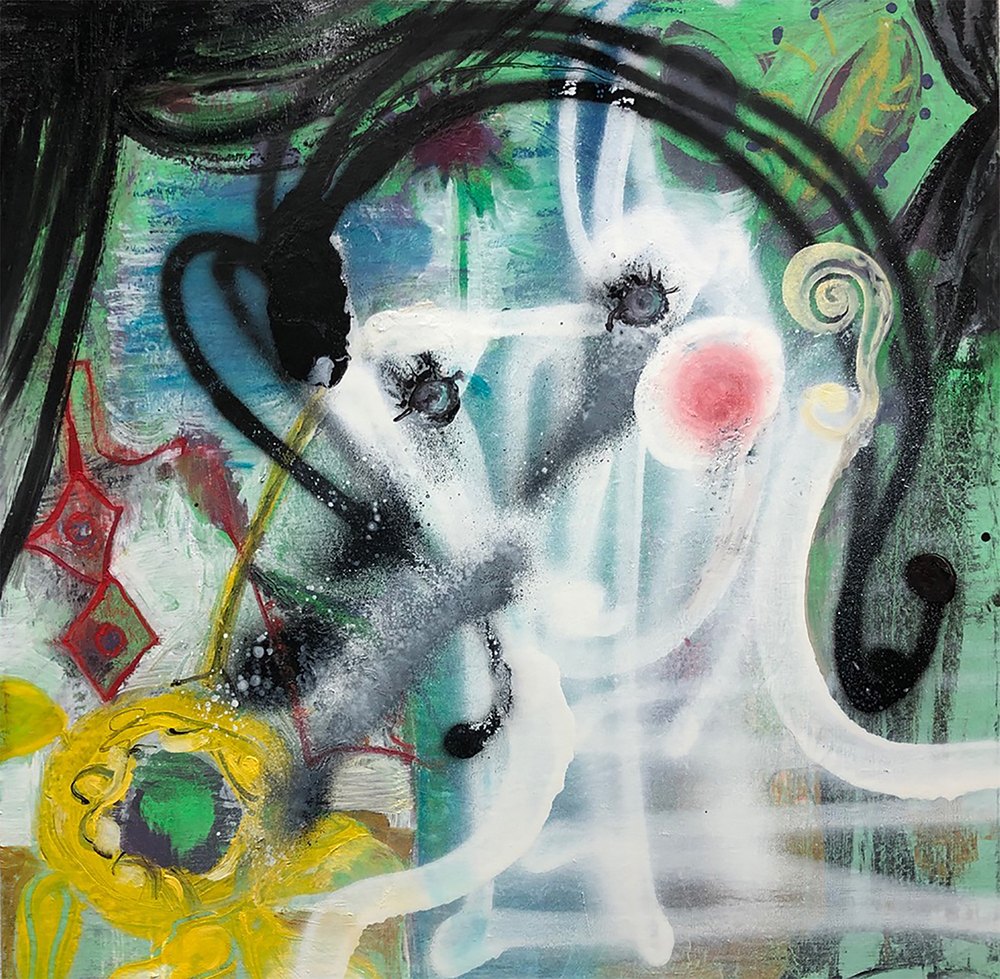
PAUL KRAINAK
Rosalyn Schwartz’s most recent work stems from an appraisal of avant-gardism and the shallow consensus about the status of studio art and contemplative art in general. She responds by addressing critical forms and subjects that question the nature of beauty and taste on one hand, while exploring feelings of anxiety and loss that has accompanied Western art since the late 19th century. Her concerns, often influenced autobiographically, disclose how the psyche remains a vital discourse in the art world and the culture at large. Playing the near-hallucinogenic against the banal she probes the often-obscured relationships between art and life –– between the provisional fiction of one and the tentative realities of the other, particularly now in our disembodied present where art and life each seem more virtual and faltering than ever. She validates the autonomous artist as a wielder of pleasure, pain, control, and loss and observes the studio as a laboratory for probing myth in both the art world and beyond.
Much of Schwartz’s career has been spent performing virtuosic painterly tasks in established genres, cannily adjusting formal and conceptual codes to suit her vision. These include reflexive variations on landscape, still life, gestural abstraction and portraiture. They’re comprised of pastiches of painting history, turbulent celebrations of form and improvisations on nature that can be simultaneously brilliant and light-absorbing –– displaying her extraordinary dexterity with color and oil mediums. Elaborate and sometimes frenetic lines, plucked seemingly from wastelands and obscure baroque cartouches, are embellished with brush strokes, pours, drips and glazing that overwhelm and then become her visual field. Lush, agreeable, yet sometimes bilious atmospheric effects blur our vision and recalibrate it in a remarkable post-millennial space.
Gestural painting in Schwartz’s hand is both form and content. A monument on sand made of illusive aspirations, unconditional love, and inadvertent transgressions, mature in the latest canvases. She nurtures a fluid interiority with few formal or conceptual restrictions. The work is performative and authorial, stemming from a life of studio experience adopting, modifying, and then spurning language intended to mediate a world where such spirited exploration and confidence is rare.
Recent personal losses have contributed to Schwartz’s paintings becoming more impassioned and assertive in recent years. Add the incomprehensible political turmoil that descended on America after Donald Trump’s surprise victory in 2016, and her retirement from the University of Illinois School of Art & Design in Urbana-Champaign, where she was Professor of Painting for 20 years. Her break from academia freed her to concentrate more exclusively in her studio, but it was compromised by a degree of mindfulness of one’s mortality –– a plaintive subject of much progressive art that’s generally romanticized in one’s youth. While the artist was always a model of improvisation, the above events encouraged her to radicalize her work, push doubt aside, and embark on a series of portraits that are more vivid and physical, almost atavistic, as anything previously. Rather than representations of an individual or even a type, they portray the subliminal. They’re scrubbed, spray-painted, and abraded as if denaturing the nucleus of self and the crux of portraiture in the process.
This sort of abandon was not always possible for Schwartz. Like many of her generation, she felt pressure to submit painting to critical theory, or become more cynical, or escapist. Instead, such dissonance was routed with pictures that explored the act of painting as a platform for internal reflection. A kind of de-sequencing of pictorial language and rituals of image-making became her method and the platform to address the relationship between the synchronic and the diachronic self –– or one’s present and historic identity. Her striking iconography asserts the expectation of a modern image –– to move the eye silently through light in extemporaneously-crafted spaces, and execute what is expected of a contemporary work, which is to assuage the cognitive ruptures in an increasingly contentious and disassociated world.
Rosalyn Schwartz works from her home studio in Urbana, Ill.

“Portrait (zoner with black curtain)” Rosalyn Schwartz. 18 inches by 18 inches, oil on canvas, 2020 (SUPPLIED IMAGE)

1 comment for “Inland Art | Rosalyn Schwartz”
Recent Comments
I have always loved Rozalyn’s work since the first painting I saw. Thank you for this intelligent and articulate review of her recent works that I plan to see when it’s safe to venture out again!